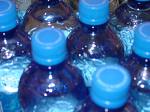Flavored water is the latest drinkable darling.
A sweet way to stay hydrated and quench thirst, but it’s often loaded with
sugar and calories!
Dietician, Kim Henderson, has five flavored waters that are smart to sip.
When it comes to beverages, there are literally hundreds of choices out
there. Today, I want to give you my 3 rules for choosing beverages that
will hydrate and keep you healthy.
· First rule: Seek out the natural alternative.
o Many times drinks marketed with a “health halo”, are nothing more
than colored sugar-water sprinkled with the in-vogue vitamin. Drinks like
Vitaminwater are a perfect example of this principle because of the
audacious claims made on the label. For example, Vitamin Water “SturD”
with calcium and vitamin D claims to “help support strong bones” because
of the 100 mg of Calcium and miniscule amount of vitamin D present in the
drink. Especially when your physical activity level, genetics, and overall diet
matter just as much or more. I would rather see you drink an 8 oz glass of
low-fat milk in which you’re getting 3 times the amount of calcium as well
as protein, potassium, phosphorous, and vitamins A and D. The point is,
is that nutrition is not a reductionist science- You get into trouble when
you stick certain health-giving properties, like stronger bones, to a single
nutrient like calcium…the truth is, the nutrients found in foods act
synergistically and work better when they come from real food and not a
multi-vitamin laced beverage. This is why all natural coconut water has
become the number one trend in the flavored water craze and is a great
alternative to vitamin-infused drinks.
o Coconut Water
. Coconut water, which came to fame as a celebrity health fad, has
become an increasingly popular way to stay hydrated or recover after a
workout. Naturally filled with electrolytes like sodium and magnesium, the
slightly sweet water has come to be seen as a natural alternative to sports
drinks like Gatorade.
. Coconut water is the liquid found within young green coconuts.
. ConsumerLabs independently tested the sodium, magnesium,
potassium, and sugar content of the 3 top selling coconut water brands
and found that only one brand, Zico Natural, contained the amounts found
on the nutrition label. The sugar and potassium content in the other two
brands, Vita Coco and O.N.E., also matched the label. But the amounts of
sodium and magnesium—two nutrients key to hydration—were as much as
82 percent and 35 percent lower than the listed amount.
. Since the electrolyte content is one of the main selling points of these
drinks, at $2 per 11 oz bottle, you may not be getting what they paid for.
. But, if you enjoy the taste of coconut water, it’s most definitely a
healthy low-calorie choice. However, you would be just as well off drinking
a glass of water and getting nutrients like sodium and potassium from
foods such as bananas and almond butter.
. Also, remember to look for “pure coconut water” on the label as some
varieties contain added sweeteners.
Which leads me to my second beverage rule:
· Eat their calories, not drink them.
o Every day, the average American consumes almost 1/2 cup of “added
sugars” and the $1 billion dollar beverage industry contributes greatly to
this high sugar intake. Simply, take the number of grams of sugar found
on the nutrition label and divide by 4 to find out how many teaspoons of
sugar are in your beverage. A bottle of Vitaminwater has 33 grams or
about 8 teaspoons of sugar. It is time to curb the American sweet tooth by
making smart beverage choicesbecause providing your body with extra
nutritionally empty calories that offer nothing in terms of vitamins,
minerals, phytonutrients, and antioxidants and promotes obesity, diabetes,
and other health problems. Beverages also do not provide us with a feeling
of fullness or satiety, the way a meal does. For example, an ounce of
almonds contains 160 calories, 3 gm fiber and 6 gm protein, and can help
tide us over between meals. But sip a 160 calorie sugar-infused beverage
and you’re likely to be just as hungry as you were before, if not more. So
eat your calories-don’t drink them.
o Hint Beverages
. I love this company’s mantra: ‘Drink water, not sugar’ which reinforces
the nutrition rule; don’t drink your calories. I also like Hint because the
flavorings used in Hint water are prepared from organically grown fruit-
keeping the soil and water free from harmful chemicals.
. You won’t run out of options with Hint. There are 10 flavors to choose
from-one of my favorites is raspberry lime.
· My third beverage rule: Stay away from artificial sweeteners
o No-calorie artificial sweeteners, though they don’t contribute extra
calories, don’t help us train our palates to get used to a lower amount of
sweetness in the diet. Though not well understood why, intake of as little
as a teaspoon of artificial sweeteners per day is associated with increased
weight. So look for sweeteners like: acesulfame potassium, saccharin, or
sucralose, or rebinia extract.
o Ayala’s Organic Herbal Water
. Ayala’s Organic Herbal Water is full of flavor yet free of calories, and
artificial sweeteners.
· It comes in 6 flavors like ginger lemon and cinnamon orange peel.
Sparkling or still-both equally hydrating. All ingredients are organic. I
really enjoyed the lemongrass vanilla mint sparkling water.
. I also like Herbal Water because the company uses practices to lessen
their impact on the environment like using sustainably harvested paper for
all of their products, vigorously recycling, and using energy efficient
manufacturing plants.
· Stay away from artificial colorings
o Marketers know that we “eat with our eyes” as much as our mouths,
which is why many beverages come in alluring bright colors. The artificial
colorings used in many beverages are synthetic chemicals made from coal
and petroleum. The common food dyes (yellow5, Red 40, Blues 1 and 2),
may pose several risks including hyperactivity in children, cancer (animal
studies), and may even exacerbate allergies. They have been banned in the
UK and Europe and are likely to be “the next trans fats” in the US.
o Metromint
. Metromint is bottled water with the essence of mint, sans any food
dyes, calories, or sweeteners.
. If you prefer a strong minty note, you will likely be a fan of Peppermint.
Slightly less potent is Spearmint. The rest of the flavors that round out the
troupe are: Lemonmint, Cherrymint, Orangemint, and Chocolatemint.
. Chocolatemint is an excellent choice to remind you of your favorite
chocolate treat, minus the calories, and is great for stopping a mid-
afternoon craving in its tracks!
. In addition to being delicious, Metromint is also a good choice from an
ethical standpoint. Its manufacturing plants use renewable energy and the
bottles are recyclable.
In my opinion, you can’t go wrong reducing your intake of empty sugar
calories and artificial sweeteners, colorings, and flavorings. What’s great is
that flavored water can also easily be made at home to tailor a flavor to
your liking, save money, and reduce plastic bottle consumption.
o Here is a pitcher I made with pineapple rings, peach slices, and a
handful of fresh mint sprigs. You can also add natural sweeteners like
lemon, lime, a slice of orange or even cucumber to your beverage for
refreshment.
o Freezing fresh berries in ice cube trays is another way to dress up a
glass of sparkling water.
Flavored water, whether it is homemade, zero calorie or coconut water, is
an easy and excellent way to hydrate and stay healthy.
Kim Henderson has her masters in nutrition and is a local dietician.















Add comment